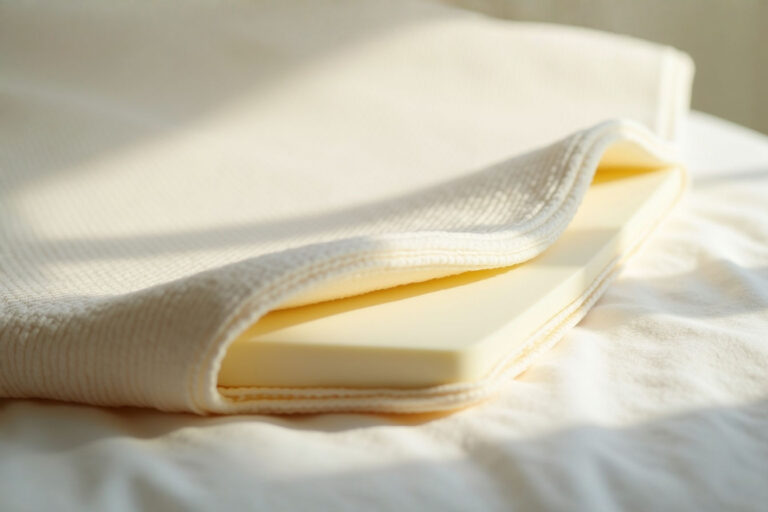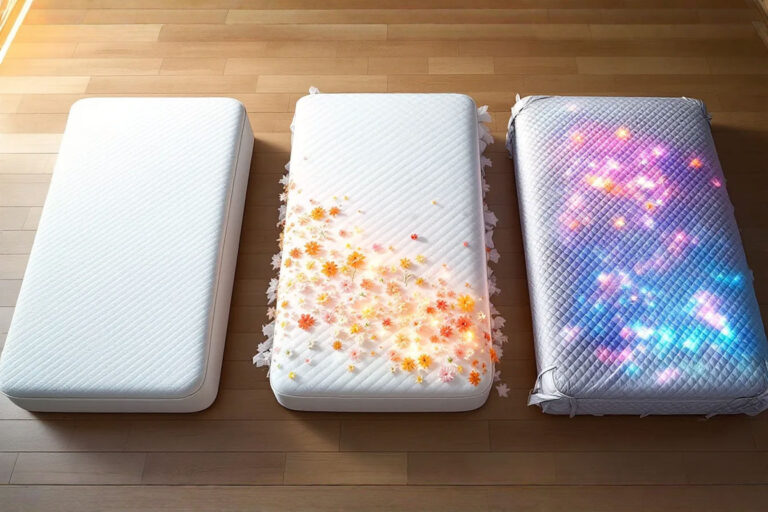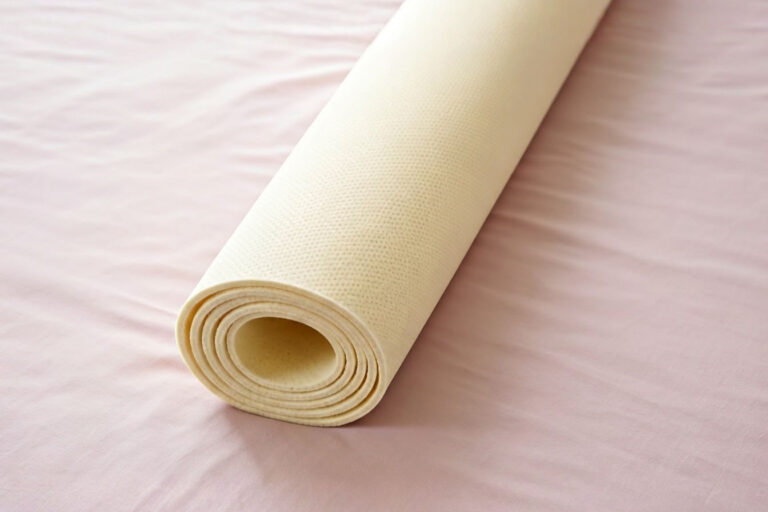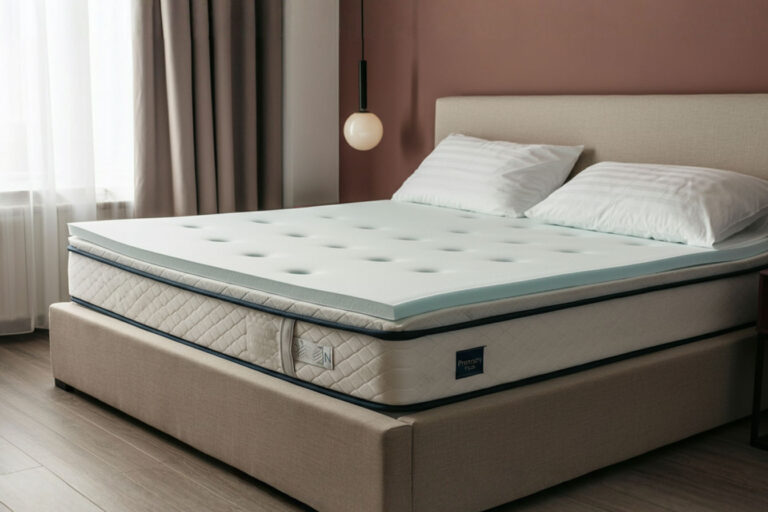Full Size Bed Topper: The Goldilocks Thickness That Works for Multiple Sleep Positions
Finding the perfect mattress topper thickness can transform your sleep. Learn which thickness works best for side, back, and stomach sleepers on a full size bed.
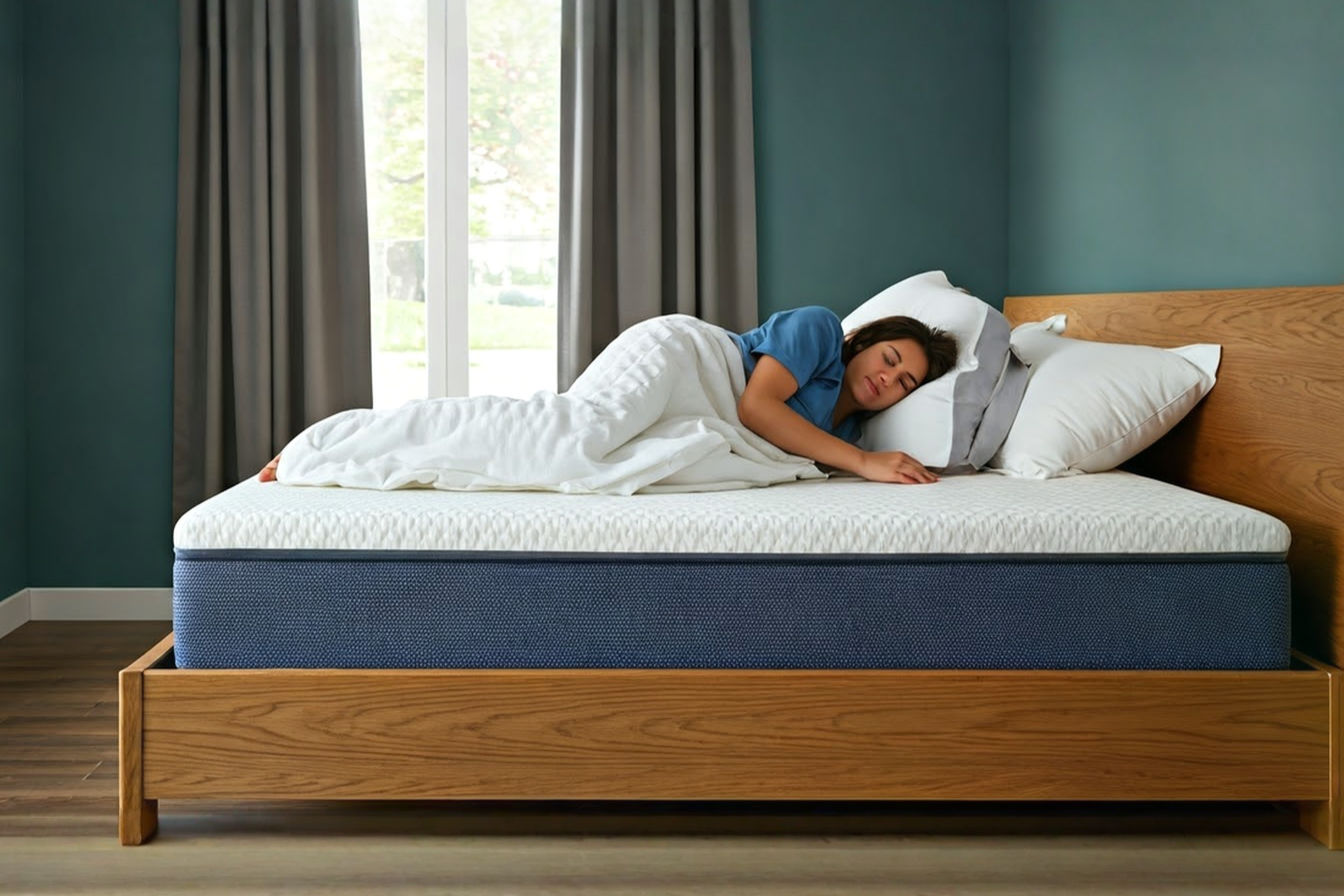
Finding the perfect mattress topper feels like an endless quest through a forest of options. Too thin, and you might as well have skipped the purchase entirely. Too thick, and suddenly your sheets don’t fit and you need a stepladder to climb into bed. The challenge intensifies when you consider that different sleep positions demand different levels of support and cushioning.
Your sleeping position naturally changes throughout the night. You might fall asleep on your side but wake up on your back or stomach. This common sleep pattern creates a genuine dilemma: how can one mattress topper possibly accommodate such varied positions and support needs?
Enter the concept of the “Goldilocks” mattress topper thickness – not too thin, not too thick, but just right for most sleepers regardless of position. This sweet spot provides enough cushioning for pressure-sensitive side sleepers while maintaining proper support for back and stomach sleepers.
In this comprehensive guide, we’ll explore how thickness affects comfort, which materials work best at different thicknesses, and how to find that perfect balance for your full size bed. We’ll also address specific sleep concerns and provide practical advice for making the most of your topper investment.
Understanding Mattress Topper Thickness: Why It Matters
How Thickness Affects Comfort and Support
The thickness of your mattress topper directly influences both comfort and support. A thinner topper provides modest cushioning while allowing you to maintain contact with your underlying mattress’s support structure. These options typically offer a subtle improvement to your sleep surface without dramatically altering its feel.
On the other hand, thicker toppers create a more significant buffer between you and your mattress. They provide enhanced pressure relief and can substantially change your bed’s feel, effectively creating a new sleep surface. The thicker the topper, the more its properties dominate your sleep experience, potentially masking your mattress’s original support characteristics.
Your body shouldn’t sink too deeply into the sleep surface, as proper spinal alignment requires adequate support. The thickness of your topper plays a crucial role in maintaining this delicate balance between soft comfort and firm support.
The Range of Available Thicknesses (1-4 inches)
Mattress toppers typically come in four standard thickness options, each serving different purposes:
1-inch toppers provide a thin layer of additional comfort without significantly changing your mattress’s feel. These work well for minor comfort adjustments or slight firmness modifications.
2-inch toppers offer a moderate comfort enhancement while maintaining a connection to your mattress’s support structure. This thickness provides a noticeable improvement without dramatically altering the sleep surface.
3-inch toppers deliver substantial cushioning and pressure relief, creating a significantly different feel from your original mattress. This thickness starts to function almost like a mini-mattress on top of your existing one.
4-inch toppers essentially transform your sleep surface entirely, virtually replacing the feel of your underlying mattress. These substantial additions provide maximum cushioning but may compromise support for some sleepers.
Impact of Thickness on Sleep Quality
The right topper thickness can transform your sleep quality by addressing specific comfort issues. A properly chosen topper helps distribute body weight evenly, reducing pressure points and allowing muscles to relax fully during sleep.
Insufficient thickness might fail to provide adequate cushioning for painful pressure points, particularly for side sleepers who concentrate body weight on shoulders and hips. Conversely, excessive thickness might cause excessive sinking, creating awkward body angles that lead to morning stiffness and pain.
Temperature regulation also varies with topper thickness. Thicker options, particularly in memory foam, tend to retain more body heat. This characteristic becomes especially relevant for full size beds, which already provide less surface area for heat dissipation compared to larger mattresses.
Balancing Cost with Performance
Price naturally increases with thickness, as more material equates to higher manufacturing costs. A 4-inch memory foam topper typically costs significantly more than its 2-inch counterpart from the same brand. This price difference becomes an important consideration when working within a budget.
However, the most expensive option isn’t necessarily the best for your specific needs. Many sleepers find that mid-range thicknesses deliver the optimal balance of comfort, support, and value. The law of diminishing returns often applies – going from 1 inch to 2 inches typically offers more noticeable improvement than going from 3 inches to 4 inches.
The ideal approach involves identifying the minimum thickness that adequately addresses your comfort needs rather than automatically selecting the thickest option available. This strategy ensures you don’t overspend on unnecessary materials that might even compromise your sleep quality.
Sleep Positions and Their Unique Topper Requirements
Side Sleepers: Pressure Relief Needs
Side sleeping creates concentrated pressure points where your body makes the most contact with the mattress – primarily the shoulders and hips. These areas bear significant weight and require ample cushioning to prevent discomfort and numbness.
Side sleepers typically benefit from toppers in the medium to thick range (2-4 inches) to provide adequate pressure relief. The shoulders and hips should sink slightly into the material, allowing the spine to maintain its natural horizontal alignment. Insufficient cushioning in these areas forces the body to adapt, potentially leading to morning soreness and long-term discomfort.
The material composition matters significantly for side sleepers. Memory foam and latex in the 2-3 inch range often provide the ideal balance of conforming support and pressure relief. These materials cradle the pressure points while supporting the waist and maintaining proper spinal alignment.
Back Sleepers: Spinal Alignment Concerns
Back sleepers distribute weight more evenly across the mattress surface, creating fewer concentrated pressure points than side sleepers. The primary concern for back sleepers revolves around lumbar support and maintaining the spine’s natural curve.
A medium thickness topper (2-3 inches) typically works well for back sleepers, providing enough cushioning for comfort without allowing excessive sinking that could disrupt spinal alignment. The material should conform to the body while supporting the natural lumbar curve.
Back sleepers should avoid ultra-thick toppers that might allow the hips to sink too deeply, creating a hammock effect that strains the lower back. The ideal topper provides a subtle cradling effect while maintaining relatively even support across the back’s entire surface.
Stomach Sleepers: Preventing Overarching
Stomach sleeping places unique demands on a mattress topper. This position naturally flattens the spine’s curve, and the challenge lies in preventing the midsection from sinking too deeply into the sleep surface, which would create uncomfortable arching in the lower back.
Thinner toppers (1-2 inches) generally work best for stomach sleepers, providing minimal cushioning without allowing significant sinking in the heavier midsection. The material should offer consistent support across the entire body to maintain neutral spinal alignment.
Density and firmness become particularly important for stomach sleepers. Even a thinner topper, if too soft, could allow excessive sinking. Medium-firm to firm materials help prevent the overarching that leads to back pain for many stomach sleepers.
Combination Sleepers: The Ultimate Challenge
For those who rotate between positions throughout the night, finding the right topper presents the ultimate challenge. Combination sleepers need a versatile option that accommodates multiple positions without compromising support or comfort in any single position.
Medium thickness toppers (2-3 inches) typically offer the best compromise for combination sleepers. This range provides adequate pressure relief for side sleeping while maintaining sufficient support for back and stomach positions.
Responsiveness matters significantly for combination sleepers who change positions frequently. Materials like latex or responsive polyfoam recover quickly when pressure shifts, facilitating easier movement compared to dense memory foam, which can create a “stuck” feeling during position changes.
The ‘Goldilocks Zone’: Finding the Ideal Thickness
Why 2-3 Inches Often Hits the Sweet Spot
The 2-3 inch thickness range represents what many consider the “Goldilocks zone” for mattress toppers – not too thin, not too thick, but just right for most sleepers. This moderate thickness provides meaningful comfort enhancement while maintaining connection to your mattress’s supportive core.
At this thickness, toppers offer substantial pressure relief without the dramatic sinking that thicker options might create. The material has sufficient depth to cushion pressure points while supporting natural body contours and spinal alignment.
This middle-ground approach works particularly well for full size mattresses, where space utilization matters. The moderate thickness doesn’t significantly raise the sleep surface height, preventing issues with fitted sheets and maintaining appropriate bed height.
Medium Thickness Benefits for Multiple Sleep Positions
Medium thickness toppers shine in their versatility across different sleep positions. The 2-3 inch range provides adequate cushioning for side sleeping pressure points while maintaining sufficient support for back and stomach positions.
For side sleepers, this thickness allows shoulders and hips to sink slightly without bottoming out against the firmer mattress below. For back sleepers, it contours to the natural lumbar curve without excessive sinking. For stomach sleepers, particularly with a firmer material, it adds comfort without compromising proper alignment.
This adaptability makes medium thickness options ideal for combination sleepers and couples with different sleep preferences sharing a full size bed. The balanced approach accommodates various body types and positions without strongly favoring one over others.
When to Go Thinner (1-2 inches)
Thinner toppers in the 1-2 inch range work best in specific situations. If your existing mattress provides good support and only needs slight comfort enhancement, a thinner option prevents unnecessary modification of an already adequate sleep surface.
Stomach sleepers often benefit from these thinner options, which provide minimal sinking for the midsection. Heavier individuals sleeping on their stomachs particularly appreciate the modest cushioning without the excessive give that thicker toppers might provide.
Thinner toppers also work well in warmer climates or for naturally hot sleepers, as they trap less body heat than thicker alternatives. The reduced material volume facilitates better airflow and heat dissipation, contributing to cooler sleep.
When to Go Thicker (3-4 inches)
Thicker toppers in the 3-4 inch range serve specific purposes in the sleep environment. When attempting to revitalize an aging mattress with deteriorating support, these substantial additions can effectively create a new sleep surface that masks significant mattress deficiencies.
Side sleepers with pronounced pressure point pain sometimes require this additional cushioning depth, particularly those with broader shoulders or wider hips. The extra material provides enhanced pressure relief for these sensitive areas.
Lightweight individuals (under 130 pounds) may also benefit from thicker toppers, as their lower body weight doesn’t compress the material as deeply. The additional thickness ensures they experience the full contouring benefits that heavier sleepers might achieve with thinner options.
Material Considerations for Full Size Bed Toppers
Memory Foam: Density vs. Thickness Tradeoffs
Memory foam remains one of the most popular mattress topper materials, known for its pressure-relieving properties. With this material, density works hand-in-hand with thickness to determine performance and durability.
Higher-density memory foam (4-5 pounds per cubic foot) offers superior durability and support, potentially allowing you to choose a slightly thinner topper without sacrificing comfort. Lower-density options (2-3 pounds per cubic foot) compress more easily, potentially requiring greater thickness to prevent “bottoming out” during the night.
For full size beds, a 2-3 inch memory foam topper with medium to high density often provides the optimal balance. This combination delivers substantial pressure relief without excessive heat retention or the engulfing sensation that thicker memory foam sometimes creates.
Latex: Natural Support and Responsiveness
Natural latex offers a responsive alternative to memory foam, providing excellent pressure relief with a more buoyant feel. Latex naturally springs back when pressure shifts, making it ideal for combination sleepers who change positions frequently.
The inherent resilience of latex means that slightly thinner options (2-2.5 inches) often provide comparable support to thicker memory foam toppers. The material efficiently distributes weight across its surface while conforming to body contours.
For full size beds, latex toppers offer excellent motion isolation without the sinking feeling associated with memory foam. The material’s natural breathability also contributes to better temperature regulation, a valuable characteristic for the somewhat limited surface area of a full size mattress.
Gel-Infused Options: Cooling Properties
Gel-infused toppers incorporate cooling gel particles or layers within the foam structure to address heat retention concerns. These options work particularly well for hot sleepers or in warmer climates where temperature regulation becomes a priority.
The cooling efficiency varies with thickness – thinner gel-infused toppers (1-2 inches) typically provide better heat dissipation than thicker options (3-4 inches), where the cooling effects may not reach the sleep surface as effectively. The gel’s effectiveness also depends on its distribution throughout the foam.
For full size beds, where two sleepers share a somewhat limited space, gel-infused toppers in the 2-3 inch range often provide the ideal balance of cooling properties and pressure relief. The enhanced temperature regulation helps offset the heat concentration that naturally occurs on smaller mattress sizes.
Down Alternative and Fiber Fills: Softness Factors
Down alternative and polyester fiber toppers offer a cloud-like softness with minimal conforming properties. These materials excel at surface-level comfort enhancement rather than deep pressure relief or support modification.
With these materials, thickness plays a slightly different role – even at 3-4 inches, fiber toppers compress significantly under body weight. This characteristic makes them less effective for addressing serious comfort issues but excellent for adding plush comfort to an already supportive mattress.
For full size beds, fiber toppers work well as secondary comfort layers, perhaps placed over a thinner memory foam or latex topper. This combination approach leverages the pressure relief of foam materials with the cloud-like surface feel of fiber fills.
Body Weight and Mattress Topper Thickness
Lightweight Sleepers (Under 130 lbs)
Lightweight individuals interact with mattress toppers differently than heavier sleepers. With less body weight to compress the material, these sleepers may not sink deeply enough into thinner toppers to experience their full pressure-relieving benefits.
For side sleeping, lightweight individuals often benefit from slightly thicker toppers (2.5-3 inches) in softer materials. This combination allows adequate sinking of shoulders and hips to maintain proper spinal alignment despite lower body weight.
Back and stomach sleeping lightweight individuals may find medium thickness options (2-2.5 inches) provide sufficient comfort without compromising support. The reduced compression from lower body weight means even moderately thick toppers maintain their supportive properties.
Average Weight Sleepers (130-230 lbs)
Average weight individuals typically experience mattress toppers as manufacturers intend. Their weight sufficiently activates the pressure-relieving properties without causing excessive compression that might compromise support.
For most average weight sleepers, the 2-3 inch range provides the ideal balance across sleep positions. Side sleepers in this weight category might prefer the upper end of this range, while back and stomach sleepers might favor the lower end.
Material density becomes particularly important for this weight group. Medium-density memory foam or medium-firm latex typically offers the most versatile performance, providing adequate sinking for pressure points while maintaining support for proper alignment.
Heavyweight Sleepers (Over 230 lbs)
Heavier individuals compress mattress toppers more deeply, potentially “bottoming out” against the underlying mattress with insufficient thickness or density. This interaction requires careful consideration of both material properties and thickness.
Surprisingly, thicker isn’t always better for heavyweight sleepers. A 3-inch high-density memory foam or firm latex topper often outperforms a 4-inch lower-density option, providing better support with less excessive sinking.
The material’s durability becomes especially important for this weight category. Higher-density foams and natural latex typically maintain their supportive properties longer under greater weight pressure, making them worth the additional investment for heavier individuals.
Couples with Different Weight Needs
Couples sharing a full size bed often have different body weights and comfort preferences, creating a genuine challenge for topper selection. The relatively limited space of a full mattress (54 inches wide) means both sleepers significantly impact each other’s sleep surface.
Medium thickness toppers (2-3 inches) in medium-firm materials typically offer the best compromise for couples with different needs. This approach provides adequate pressure relief for the lighter partner without excessive sinking for the heavier one.
For significant weight disparities, latex often outperforms memory foam in accommodating different body types on the same surface. Its more responsive nature adapts to different pressure levels while maintaining consistent support across the mattress width.
Full Size Bed Considerations for Topper Selection
Standard Full Size Dimensions and Fit
A standard full size mattress measures 54 inches wide by 75 inches long, providing a somewhat cozy sleeping arrangement for couples. This limited width makes proper topper fit particularly important to maximize the usable sleep surface.
When purchasing a full size mattress topper, look for options that match these dimensions precisely. Undersized toppers leave portions of the mattress uncovered, creating uncomfortable transitions, while oversized options bunch up against headboards or footboards.
Consider toppers with elastic straps or fitted skirts that secure the product to the mattress. These features prevent shifting during the night – a valuable characteristic for the limited space of a full size bed where even slight misalignment can affect comfort.
Edge Support and Full Size Toppers
Edge support becomes particularly important on full size beds where every inch of usable space matters. Some mattress toppers, particularly thicker memory foam options, compress significantly at the edges, effectively reducing the usable sleep surface.
Latex and higher-density memory foam typically provide better edge support than lower-density alternatives. These materials maintain more consistent support from the center to the edges, maximizing the functional sleep area.
For couples sharing a full size bed, consistent edge-to-edge support allows both sleepers to utilize the entire surface comfortably. This characteristic becomes especially valuable when the limited 54-inch width already creates space constraints.
Motion Isolation for Couples on Full Size Beds
Motion transfer concerns intensify on full size mattresses, where partners sleep in closer proximity than on larger beds. The right topper can significantly improve motion isolation, preventing sleep disruption when one partner moves.
Memory foam excels in motion isolation, absorbing movement rather than transferring it across the sleep surface. Thicker options (2-3 inches) generally provide better motion absorption, creating a more stable sleep environment for couples.
Latex offers a different motion isolation approach, dampening movement while providing a more responsive feel than memory foam. This characteristic works well for couples who want improved motion isolation without the slow-responding properties of memory foam.
Temperature Regulation on Smaller Mattresses
Full size mattresses concentrate body heat more than larger options simply due to their smaller surface area. Two sleepers generate significant warmth with limited space for heat dissipation, making temperature regulation an important consideration.
Topper material significantly affects temperature management. Traditional memory foam retains the most heat, while gel-infused versions, open-cell foam, and latex provide progressively better cooling properties.
Topper thickness also impacts temperature regulation, with thicker options typically retaining more heat regardless of material. For hot sleepers sharing a full size bed, moderately thick toppers (2-3 inches) in breathable materials like latex or gel-infused foam often provide the best balance of comfort and cooling.
Addressing Specific Sleep Issues with the Right Thickness
Pain Relief: Back, Hip, and Shoulder Concerns
Different pain patterns require specific topper solutions, with thickness playing a crucial role in addressing various discomfort sources. Back pain, particularly in the lumbar region, typically benefits from medium thickness toppers (2-3 inches) that support the natural spinal curve.
Hip pain often responds well to slightly thicker options (2.5-3 inches) that provide enhanced pressure relief for this weight-bearing joint. The material should allow the hip to sink slightly while supporting the surrounding areas to maintain alignment.
Shoulder pain, common among side sleepers, frequently requires substantial cushioning. Toppers in the 2.5-3.5 inch range typically provide enough depth to accommodate shoulder width without creating alignment issues for the rest of the body.
Pressure Point Reduction Strategies
Effective pressure point relief requires the right combination of topper thickness, material, and density. The topper must provide enough depth to distribute weight evenly across its surface rather than concentrating it on protruding body parts.
Side sleepers experience the most significant pressure concerns, with concentrated weight on shoulders and hips. These sleepers typically benefit from toppers in the 2.5-3 inch range that provide adequate depth for these body parts to sink while supporting the waist.
Back and stomach sleepers generally experience fewer pressure point issues but still benefit from moderate cushioning. Toppers in the 1.5-2.5 inch range typically provide sufficient pressure relief without compromising alignment for these positions.
Improving Old or Sagging Mattresses
Rejuvenating an aging mattress represents one of the most common reasons for purchasing a topper. In these cases, thickness requirements increase to compensate for the underlying mattress’s deficiencies.
For mattresses with minor sagging or softening, a 2-3 inch topper often provides sufficient renewal. This thickness adds meaningful support while integrating with the remaining useful characteristics of the existing mattress.
Severe sagging requires more substantial intervention. Toppers in the 3-4 inch range essentially create a new sleep surface, minimizing the impact of the compromised mattress below. These thicker options work best in firmer materials like high-density memory foam or firm latex to compensate for the lack of underlying support.
Enhancing New But Too-Firm Mattresses
New mattresses sometimes prove firmer than expected, creating an uncomfortable sleep experience despite their structural integrity. These situations typically require less dramatic intervention than aging mattresses.
A 1-2 inch topper often provides sufficient softening for a too-firm mattress without significantly altering its supportive characteristics. This moderate addition creates a comfort buffer while allowing the sleeper to benefit from the new mattress’s proper support structure.
Material selection becomes particularly important in these cases. Memory foam provides the most dramatic softening effect, while latex offers a more moderate adjustment. The goal involves adding targeted cushioning without undermining the supportive elements that make a new mattress valuable.
Practical Considerations for Mattress Topper Ownership
Lifespan Expectations by Thickness and Material
Mattress topper longevity varies significantly based on both material and thickness. Thicker toppers typically outlast thinner versions of the same material, simply because they contain more material to compress before becoming ineffective.
High-quality memory foam toppers in the 2-3 inch range generally maintain their supportive properties for 3-5 years with proper care. Latex options offer superior durability, typically lasting 5-7 years before significant compression or breakdown occurs.
Lower-density foam and fiber-filled toppers have shorter lifespans, typically performing optimally for 1-3 years depending on thickness and use patterns. This shorter lifespan offsets their lower initial cost, creating a different value proposition for budget-conscious shoppers.
Cleaning and Maintenance Based on Thickness
Topper thickness affects maintenance requirements and methods. Thinner toppers (1-2 inches) typically offer easier handling for regular maintenance like rotating, airing out, and spot cleaning. Their lighter weight makes them manageable for a single person to remove and replace.
Thicker toppers (3-4 inches) present greater maintenance challenges, particularly on full size beds where maneuvering space may be limited. These substantial additions often require two people to handle effectively during cleaning or rotation, especially memory foam versions that become unwieldy when not fully supported.
Many toppers come with removable, washable covers that significantly simplify maintenance regardless of thickness. These protective layers shield the foam or filling from body oils, sweat, and spills that might otherwise compromise material integrity and performance.
Storage Solutions for Various Thicknesses
Proper storage preserves your mattress topper’s performance and extends its useful life when not in use. Thickness significantly impacts storage requirements and methods, with thicker options demanding more space and careful handling.
Thinner toppers (1-2 inches) roll relatively easily for compact storage, fitting in moderately sized storage containers or closet spaces. Their flexibility allows for various storage configurations when space is limited.
Thicker options, particularly memory foam, require more thoughtful storage approaches. These toppers should ideally be stored flat to prevent permanent compression lines or folds. When flat storage isn’t possible, loosely rolling (rather than folding) provides the next best option, though this still requires substantial space.
Vacuum-sealed storage bags offer a temporary solution for all topper thicknesses but should not be used for extended periods with foam products. The compression can damage the internal structure of foam cells if maintained too long, potentially affecting the topper’s performance when returned to use.
When to Replace Your Mattress Topper
Recognizing the right time to replace your mattress topper prevents sleeping on a product that no longer provides adequate support. Visible indentations that remain even after periods without pressure indicate compression that won’t recover.
Thickness affects replacement timing—thinner toppers typically show wear more quickly than thicker options in the same material. A 1-inch memory foam topper might develop permanent body impressions within 1-2 years of regular use, while a 3-inch version might maintain its shape for 3-5 years.
Performance degradation offers another replacement indicator. When your topper no longer improves sleep quality or comfort—when pressure points return or support feels compromised—it’s time to consider a replacement regardless of the topper’s age or appearance.
Conclusion
Finding the perfect mattress topper thickness involves balancing numerous factors—sleep position, body weight, existing mattress condition, and personal comfort preferences. While individual needs vary, the 2-3 inch range often emerges as the versatile “Goldilocks zone” that satisfies most sleepers across multiple positions.
This medium thickness provides meaningful pressure relief for side sleepers without creating excessive sinking for back and stomach positions. It offers substantial comfort enhancement while maintaining connection to your mattress’s supportive core. For most sleepers sharing a full size bed, this balanced approach delivers the optimal combination of comfort, support, and practicality.
Remember that material works hand-in-hand with thickness to determine performance. A 2-inch high-density memory foam topper might provide better support than a 3-inch lower-density option. Similarly, the inherent responsiveness of latex allows slightly thinner versions to perform comparably to thicker memory foam alternatives.
Ultimately, your perfect topper thickness depends on your unique sleep profile and comfort needs. By understanding how thickness affects performance across different materials and sleep positions, you can make an informed investment in better sleep—finding that “just right” option that transforms your full size bed into the perfect sleep sanctuary, regardless of how you prefer to rest.

